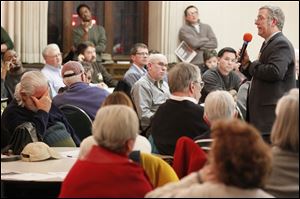
Residents hear about changes along Collingwood
1/9/2012
David Dysard, Ohio Department of Transportation district deputy director, speaks at The Historic District Commission of the Old West End meeting about the city's planned reconstruction of Collingwood Boulevard.
There was little dispute among residents who attended Monday night’s Old West End Historic District Commission meeting that Collingwood Boulevard is deplorable and the street needs repaved.
But, the idea that decades-old trees along the street of restored Victorian mansions and historic churches will be taken down is offensive to the associations’s preservation minded dwellers.
City officials told more than 100 people who packed a conference room in Collingwood Presbyterian Church about plans for a complete reconstruction of the street from Monroe Street to Central Avenue.
Not only will the existing pavement and curbs be removed and replaced, but the six-inch waterline buried under the street and sidewalks will be torn out and a larger supply line will be installed.
David Dysard, administrator of planning and design in engineering services, explained to residents that the trees must be removed because the digging will damage and weaken tree roots to the point that they will not be able to survive.
“When you dig four feet down you basically undermine the root structure. It breaks our hearts to do it, but all these trees will have to go because of this project,” he said. “There is no way to avoid it.”
To ease residents’ concerns about losing their beloved trees, Mr. Dysard said new trees will be planted along the street from Winthrop Street to Monroe in a way that will give trees the opportunity to flourish.
He said the sidewalk will be rebuilt along the curb, opening up more space for tree between sidewalks and yards of homes and buildings, where they will receive more moisture and be protected from salt used for snow removal.
Planning for the project goes back to 2008 when the city applied for a state grant. Approved the following year, Mr. Dysard said the city undertook utility and design work in 2010 and subsequently met with the association board to get input on any changes they thought could be done.
Work is expected to start in June and be completed by November 2013. Work will be halted at times during the winter season.
Among the ideas offered by the association and incorporated into the project will be changing Collingwood from four lanes to two lanes in some sections, building islands, and providing some on-street parking.
Kathleen Gagen of Batavia Street said improvements to Collingwood are needed but she expressed concerns about how the changes will effect landscaping in the neighborhood.
“I think [the project] has some benefits. I am concerned about changing the historic character of the neighborhood. Most of us moved to the Old West End because of the historic character. We love our old houses,” she said.